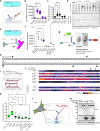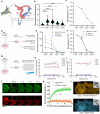This is a preprint.
Genetically encoded mechano-sensors with versatile readouts and compact size
- PMID: 39868242
- PMCID: PMC11760715
- DOI: 10.1101/2025.01.16.633409
Genetically encoded mechano-sensors with versatile readouts and compact size
Abstract
Mechanical forces are critical for virtually all fundamental biological processes, yet quantification of mechanical forces at the molecular scale in vivo remains challenging. Here, we present a new strategy using calibrated coiled coils as genetically encoded, compact, tunable, and modular mechano-sensors to substantially simplify force measurement in vivo, via diverse readouts (luminescence, fluorescence and analytical biochemistry) and instrumentation readily available in biology labs. We demonstrate the broad applicability and ease-of-use of these coiled coil mechano-sensors by measuring forces during cytokinesis (formin Cdc12) and endocytosis (epsin Ent1) in yeast, force distributions in nematode axons (β-spectrin UNC-70), and forces transmitted to the nucleus (mini-nesprin-2G) and within focal adhesions (vinculin) in mammalian cells. We report discoveries in intracellular force transmission that have been elusive to existing tools.
Conflict of interest statement
Declaration of interests Julien Berro, Yuan Ren and Yongli Zhang have a pending patent application PCT/US2023/069505.
Figures



Similar articles
-
Mechanisms of force transmission on cytokinesis Formin Cdc12 in fission yeast revealed by coiled-coil force sensors.bioRxiv [Preprint]. 2025 May 14:2025.05.14.653946. doi: 10.1101/2025.05.14.653946. bioRxiv. 2025. PMID: 40463277 Free PMC article. Preprint.
-
Comparison of Two Modern Survival Prediction Tools, SORG-MLA and METSSS, in Patients With Symptomatic Long-bone Metastases Who Underwent Local Treatment With Surgery Followed by Radiotherapy and With Radiotherapy Alone.Clin Orthop Relat Res. 2024 Dec 1;482(12):2193-2208. doi: 10.1097/CORR.0000000000003185. Epub 2024 Jul 23. Clin Orthop Relat Res. 2024. PMID: 39051924
-
Behavioral interventions to reduce risk for sexual transmission of HIV among men who have sex with men.Cochrane Database Syst Rev. 2008 Jul 16;(3):CD001230. doi: 10.1002/14651858.CD001230.pub2. Cochrane Database Syst Rev. 2008. PMID: 18646068
-
Factors that impact on the use of mechanical ventilation weaning protocols in critically ill adults and children: a qualitative evidence-synthesis.Cochrane Database Syst Rev. 2016 Oct 4;10(10):CD011812. doi: 10.1002/14651858.CD011812.pub2. Cochrane Database Syst Rev. 2016. PMID: 27699783 Free PMC article.
-
Management of urinary stones by experts in stone disease (ESD 2025).Arch Ital Urol Androl. 2025 Jun 30;97(2):14085. doi: 10.4081/aiua.2025.14085. Epub 2025 Jun 30. Arch Ital Urol Androl. 2025. PMID: 40583613 Review.
References
Publication types
Grants and funding
LinkOut - more resources
Full Text Sources
